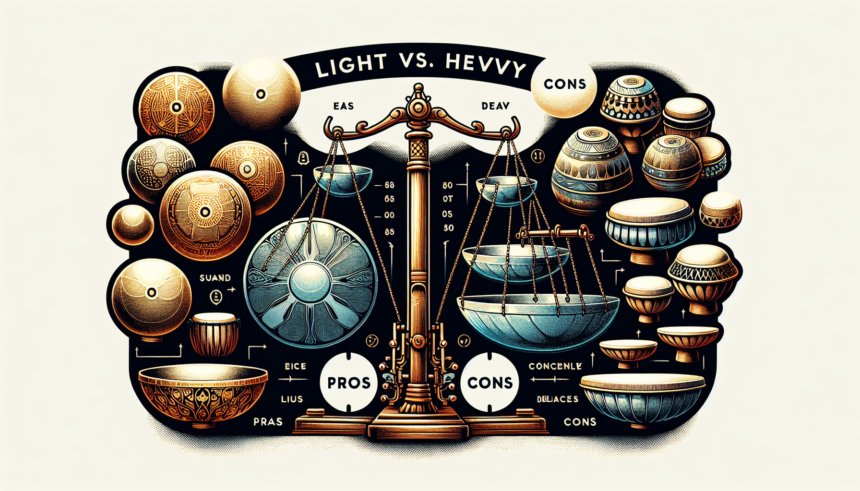<!DOCTYPE html>
<html lang="en">
<head>
<meta charset="UTF-8">
<meta name="viewport" content="width=device-width, initial-scale=1.0">
<title>Light vs. Heavy Handpans: Pros and Cons</title>
</head>
<body>
<article>
<header>
<h1>Light vs. Heavy Handpans: Pros and Cons</h1>
</header>
<section>
<h2>Introduction</h2>
<p>Handpans have taken the musical world by storm since their invention. These steel instruments offer a unique sound, combining elements from drums and bells. But when choosing a handpan, one significant debate often arises—should you go for a light or heavy handpan? Each type comes with its own set of advantages and disadvantages. This article will delve into the pros and cons of both light and heavy handpans to help you make an informed decision.</p>
</section>
<section>
<h2>Light Handpans</h2>
<p>A light handpan is typically considered more portable and easier to handle. These instruments often weigh between 5 to 10 pounds, making them a feasible choice for individuals who need to carry them around frequently, such as street performers or traveling musicians.</p>
<h3>Pros of Light Handpans</h3>
<ul>
<li><strong>Portability:</strong> The most obvious advantage of a light handpan is its portability. You can easily carry it around, whether you're going to a gig or just jamming with friends.</li>
<li><strong>Flexibility:</strong> Being lightweight also means it's easier to maneuver during performances, giving you the flexibility to experiment with different playing techniques and positions.</li>
<li><strong>Cost:</strong> Generally, light handpans tend to be less expensive compared to their heavier counterparts. This makes them an attractive option for beginners or those on a budget.</li>
</ul>
<h3>Cons of Light Handpans</h3>
<ul>
<li><strong>Sound Quality:</strong> One downside is that lighter handpans often have less resonance and depth in their sound. The tonal quality might not be as rich compared to heavier models.</li>
<li><strong>Durability:</strong> Lighter handpans may be more susceptible to dents and damage. The thinner material used can get deformed easily, affecting the sound quality over time.</li>
<li><strong>Limited Tuning Stability:</strong> Because of their light weight, these handpans might go out of tune more frequently, requiring regular maintenance.</li>
</ul>
</section>
<section>
<h2>Heavy Handpans</h2>
<p>Heavy handpans typically weigh between 10 to 20 pounds, and they bring an entirely different set of characteristics to the table. These instruments are often favored by seasoned performers and those who prioritize sound quality over portability.</p>
<h3>Pros of Heavy Handpans</h3>
<ul>
<li><strong>Sound Quality:</strong> Heavy handpans usually offer a richer and more resonant sound. The additional weight contributes to better tonal depth and sustain, making them a popular choice for serious musicians.</li>
<li><strong>Durability:</strong> The thicker material used in heavy handpans makes them more resistant to dents and damage. They are generally more robust and can withstand the rigors of frequent use.</li>
<li><strong>Tuning Stability:</strong> These handpans tend to maintain their tuning better over time, thanks to their more resilient construction.</li>
</ul>
<h3>Cons of Heavy Handpans</h3>
<ul>
<li><strong>Portability:</strong> The biggest drawback of heavy handpans is their weight. Transporting them can be cumbersome, especially if you need to carry them over long distances.</li>
<li><strong>Cost:</strong> Generally speaking, heavy handpans are more expensive due to the higher quality materials and craftsmanship involved. This can be a considerable investment, particularly for newcomers.</li>
<li><strong>Flexibility:</strong> The added weight can make it difficult to try different playing positions and techniques. This reduces the flexibility you have during performances.</li>
</ul>
</section>
<section>
<h2>Conclusion</h2>
<p>Choosing between a light and heavy handpan boils down to your specific needs and priorities. If portability and cost are your primary concerns, a light handpan may be the best option. However, if you value sound quality, durability, and stability, investing in a heavy handpan could be the better choice. Consider trying out both types to see which one aligns with your playing style and musical goals. Each type has its unique properties that can cater to different kinds of musical experiences.</p>
</section>
<section>
<h2>FAQs</h2>
<h3>1. Are light handpans suitable for beginners?</h3>
<p>Yes, light handpans are often recommended for beginners due to their affordability and ease of handling. However, beginners should also consider the trade-offs in sound quality and durability.</h3>
<h3>2. Can heavy handpans be used for outdoor performances?</h3>
<p>While heavy handpans can be used for outdoor performances, their weight makes them less convenient to transport. However, their superior sound quality often makes the extra effort worthwhile.</h3>
<h3>3. How often do light handpans need to be tuned?</h3>
<p>Light handpans generally require more frequent tuning compared to heavy handpans, especially if they are used regularly. The frequency of tuning depends on various factors, including the quality of the instrument and how it is played.</h3>
<h3>4. What is the average cost difference between light and heavy handpans?</h3>
<p>Light handpans can range from $500 to $1500, whereas heavy handpans generally cost between $1500 and $4000. Prices vary based on the maker, materials, and overall quality of the instrument.</h3>
<h3>5. Are there hybrid handpans that offer a balance between weight and sound quality?</h3>
<p>Yes, some manufacturers offer handpans that aim to balance the benefits of both light and heavy instruments. These hybrid models can provide a middle ground in terms of portability, sound quality, and durability, although they can also be more costly.</p>
</section>
</article>
</body>
</html>Light vs. Heavy Handpans: Pros and Cons

Leave a comment




